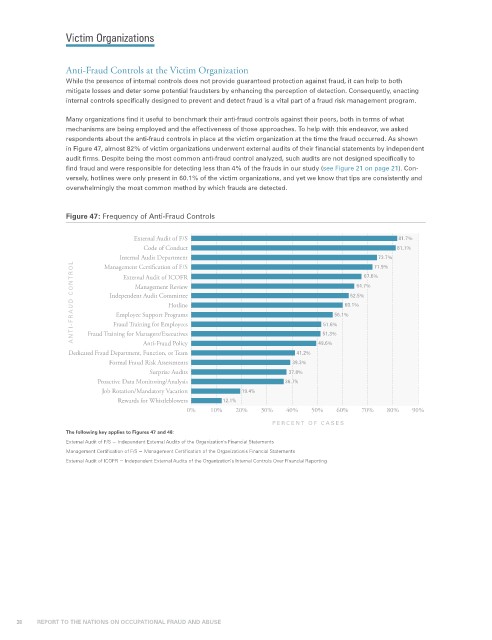Page 522 - ACFE Fraud Reports 2009_2020
P. 522
Victim Organizations
Anti-Fraud Controls at the Victim Organization
While the presence of internal controls does not provide guaranteed protection against fraud, it can help to both
mitigate losses and deter some potential fraudsters by enhancing the perception of detection. Consequently, enacting
internal controls specifically designed to prevent and detect fraud is a vital part of a fraud risk management program.
Many organizations find it useful to benchmark their anti-fraud controls against their peers, both in terms of what
mechanisms are being employed and the effectiveness of those approaches. To help with this endeavor, we asked
respondents about the anti-fraud controls in place at the victim organization at the time the fraud occurred. As shown
in Figure 47, almost 82% of victim organizations underwent external audits of their financial statements by independent
audit firms. Despite being the most common anti-fraud control analyzed, such audits are not designed specifically to
find fraud and were responsible for detecting less than 4% of the frauds in our study (see Figure 21 on page 21). Con-
versely, hotlines were only present in 60.1% of the victim organizations, and yet we know that tips are consistently and
overwhelmingly the most common method by which frauds are detected.
Figure 47: Frequency of Anti-Fraud Controls
External Audit of F/S 81.7%
Code of Conduct 81.1%
Internal Audit Department 67.6% 71.9%
73.7%
ANTI-FRA UD CONTROL Independent Audit Committee 51.6% 56.1% 60.1% 64.7%
Management Certification of F/S
External Audit of ICOFR
Management Review
62.5%
Hotline
Employee Support Programs
Fraud Training for Employees
Fraud Training for Managers/Executives
51.3%
Anti-Fraud Policy
Dedicated Fraud Department, Function, or Team 41.2% 49.6%
Formal Fraud Risk Assessments 39.3%
Surprise Audits 37.8%
Proactive Data Monitoring/Analysis 36.7%
Job Rotation/Mandatory Vacation 19.4%
Rewards for Whistleblowers 12.1%
0% 10% 20% 30% 40% 50% 60% 70% 80% 90%
PERCENT OF CASES
The following key applies to Figures 47 and 48:
External Audit of F/S = Independent External Audits of the Organization’s Financial Statements
Management Certification of F/S = Management Certification of the Organization’s Financial Statements
External Audit of ICOFR = Independent External Audits of the Organization’s Internal Controls Over Financial Reporting
38 REPORT TO THE NATIONS ON OCCUPATIONAL FRAUD AND ABUSE

